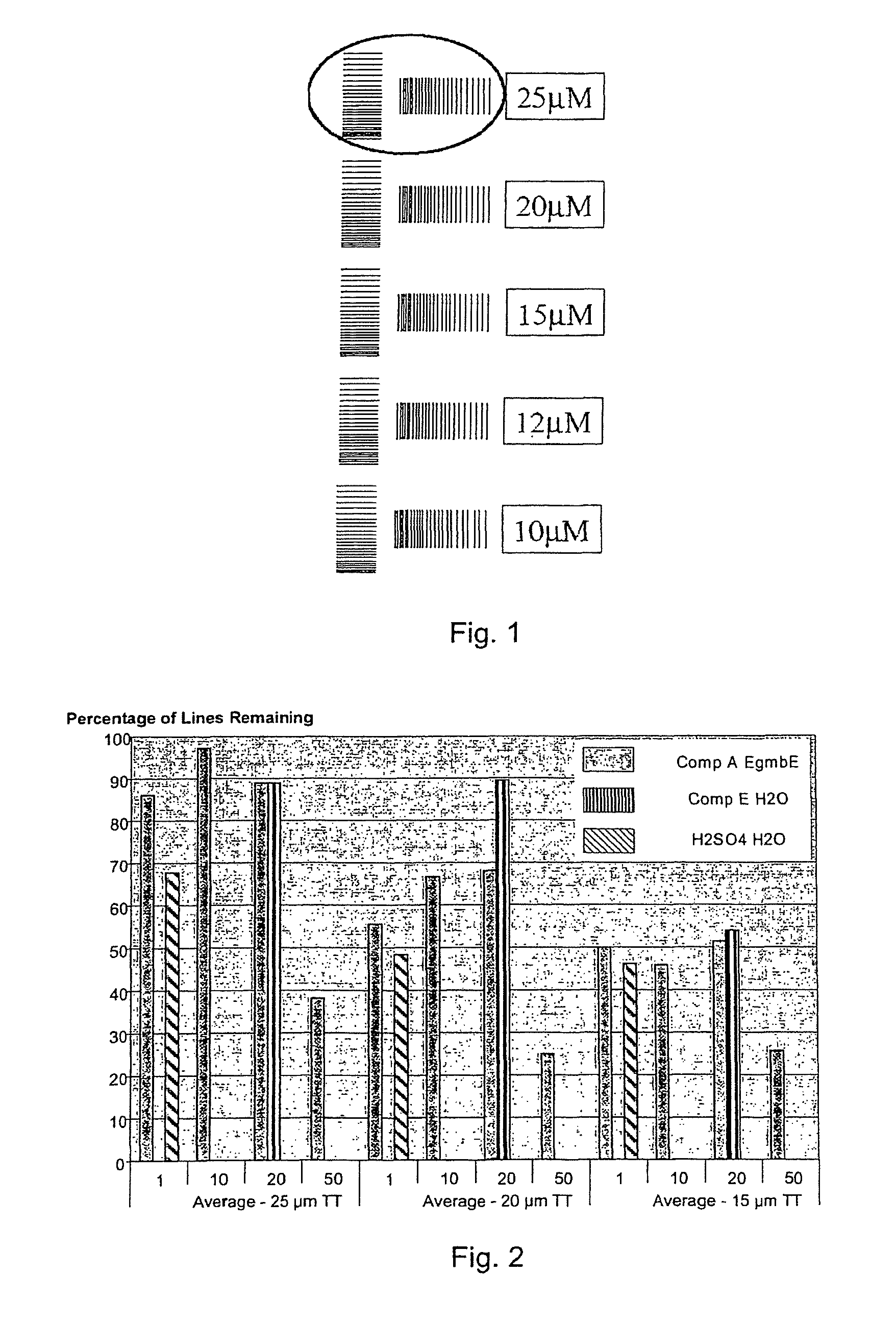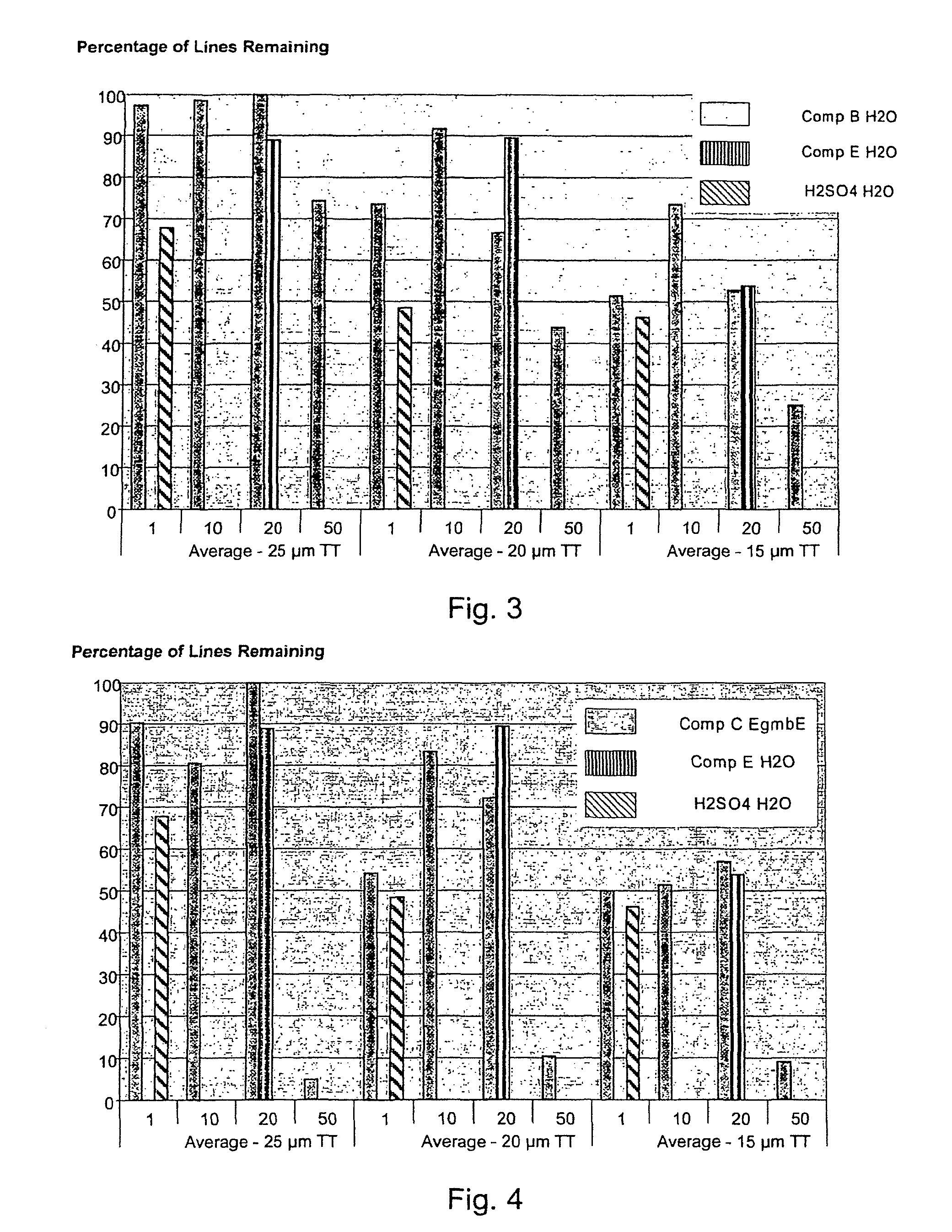Non-etching non-resist adhesion composition and method of preparing a work piece
a non-etching, non-resist adhesion technology, applied in the direction of resistive material coating, non-metallic protective coating application, textiles and paper, etc., can solve the problems of not being able to accept the risk of completely removing the copper layer in at least one region on the surface, and not being able to use etching solutions in recent most sophisticated processes, etc., to achieve good adhesion of resist coating
- Summary
- Abstract
- Description
- Claims
- Application Information
AI Technical Summary
Benefits of technology
Problems solved by technology
Method used
Image
Examples
example 1
Concentration Dependency
[0139]First tests were performed on test panels Type A. The results obtained with the acrylic compounds A, B, C and D were in each case compared to results obtained with heterocyclic compound E according to the invention and with reference sample X (FIGS. 2-5). As there could not be detected any significant difference between the individual compounds and the reference sample being tested before applying a Scotch® tape, the graphs shown in FIGS. 2-5 refer to line integrity after tape testing.
[0140]A concentration of compounds A, B, C, D and E of 10-20 mg / l was found to give best performance. Adhesion performance of all compounds was superior compared to reference sample X. A comparison of the results for 10 mg / l compositions containing the compounds and for the reference sample X is shown in FIG. 6. Interestingly, compounds A and C performed in most cases a little worse than compounds B and D. This difference was believed to be due to the solvent being used to...
example 2
Solvent and Panel Type Influence
[0141]This experiment was performed to observe the effect of the solvent and of the panel type on line integrity. Therefore, all tests were made on test panels Type A and Type B. Furthermore, acrylic compounds C and D were both dissolved in deionized water or in ethylene glycol monobutylether, respectively, in order to directly compare the influence of this solvent. The concentration of these compounds in the adhesion agent composition was 10 mg / l.
[0142]The results obtained after tape testing are shown in FIG. 7 (Type A material) and FIG. 8 (Type B material).
[0143]For Type A material, compound B being dissolved in ethylene glycol monobutylether to give the standard solution, gave similar results as compound B being dissolved in water on Type A material. Performance of compound D was always better without the ether solvent. Compared to compound E according to the invention, all results were more or less similar for all compounds (except for reference s...
example 3
Comparison of Influence of Compound F on Resist Adherence
[0148]In these experiments compounds D, E, F and G (concentration: 1-100 mg / l) were investigated, with F being investigated with and without further post-dip in an aqueous solution of 1-hydroxyethylidene 1,1 diphosphonic acid and compared to reference sample X. Tests were performed on Type A material (FIG. 11; “PD”: post-dip). Visual inspection was made before and after tape testing (“TT”).
[0149]Further, an alternative representation of the data obtained is shown in the diagram of FIG. 12, this diagram showing the improvement in [%] over treatment with Sample X.
[0150]The results of these tests after tape testing show that compound D has a slightly worse performance than compound E and that performance of compound F is comparable to that of Compound E.
[0151]A further experiment showing superior performance of a two-step method comprising treating the base material with compound F in a first method step and with 1-hydroxyethylid...
PUM
| Property | Measurement | Unit |
|---|---|---|
| concentration | aaaaa | aaaaa |
| depth | aaaaa | aaaaa |
| thickness | aaaaa | aaaaa |
Abstract
Description
Claims
Application Information
 Login to View More
Login to View More - R&D
- Intellectual Property
- Life Sciences
- Materials
- Tech Scout
- Unparalleled Data Quality
- Higher Quality Content
- 60% Fewer Hallucinations
Browse by: Latest US Patents, China's latest patents, Technical Efficacy Thesaurus, Application Domain, Technology Topic, Popular Technical Reports.
© 2025 PatSnap. All rights reserved.Legal|Privacy policy|Modern Slavery Act Transparency Statement|Sitemap|About US| Contact US: help@patsnap.com



